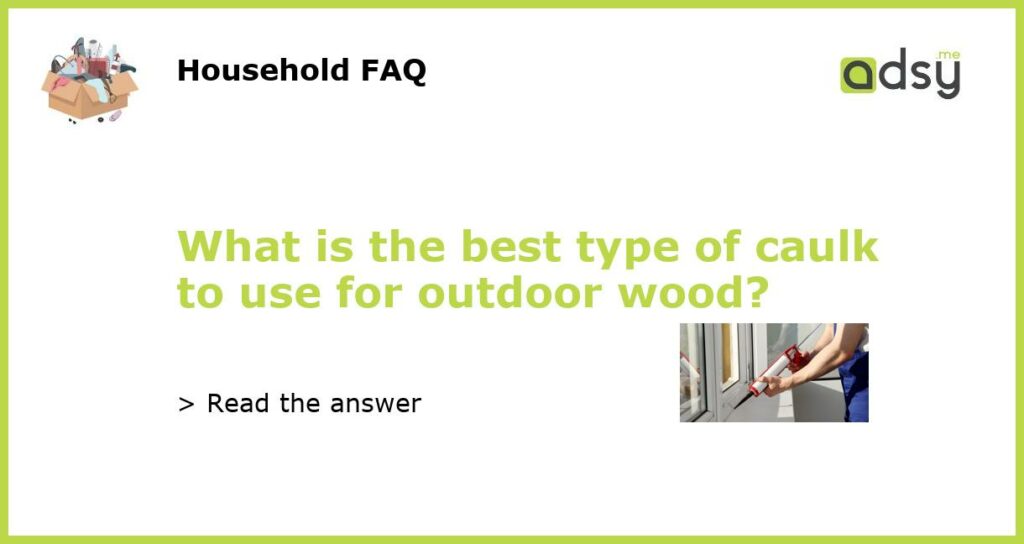Top 5 Outdoor Caulks for Wood: A Guide to Choosing the Best Option
If you’re looking to seal gaps and cracks in your outdoor wooden structures, finding the right caulk is essential. Exposure to outdoor elements such as sunlight, rain, and temperature changes can quickly damage and deteriorate wood if not properly protected. Choosing the best type of caulk will ensure a long-lasting and weather-resistant seal. In this article, we’ll explore the top five outdoor caulk options for wood and discuss their benefits and applications.
Silicone Caulk – The Superior Weather-Resistant Option
Silicone caulk is widely regarded as the best choice for outdoor wood due to its exceptional weather resistance and durability. Unlike other caulks, silicone caulk maintains its flexibility even in extreme temperatures, preventing cracking and splitting. Additionally, it provides excellent waterproofing and protects against moisture and UV rays, making it ideal for sealing gaps and joints in outdoor wood structures like decks, fences, and windows.
Acrylic Latex Caulk – A Budget-Friendly Alternative
If you’re looking for a more affordable option that still offers decent weather resistance, acrylic latex caulk is worth considering. It’s easy to work with, dries quickly, and can be painted over once cured. While not as durable as silicone caulk, it provides adequate protection against mild outdoor elements and is suitable for sealing smaller gaps and cracks in non-exposed areas. However, it’s important to note that acrylic latex caulk may not perform well in extreme temperatures or areas with high moisture levels.
Polyurethane Caulk – Ideal for High-Moisture Environments
For outdoor wood structures exposed to constant moisture or submerged conditions, polyurethane caulk is the top choice. It forms a watertight seal and offers excellent resistance to water, making it perfect for sealing wooden boats, docks, or outdoor furniture. Polyurethane caulk also provides good adhesion and flexibility, allowing it to withstand expansion and contraction caused by temperature changes. Keep in mind that polyurethane caulk tends to be more expensive and has a longer curing time compared to other options.
Butyl Rubber Caulk – The Go-To Option for Gutters and Roofs
If you’re specifically looking to seal gaps, joints, or seams in gutters and roofing, butyl rubber caulk is the recommended choice. Its exceptional water resistance and flexibility make it perfect for protecting these areas from leaks caused by rain and melting snow. Butyl rubber caulk adheres well to various surfaces and can maintain its performance for many years. However, it’s important to ensure the surface is clean and dry before applying this caulk to achieve the best adhesion and weatherproofing results.
Epoxy Caulk – A Strong and Durable Option for Repairs
When it comes to repairing damaged outdoor wood, epoxy caulk is a reliable choice. It provides excellent adhesion and fills gaps and cracks effectively, creating a sturdy and long-lasting bond. Epoxy caulk can withstand harsh outdoor conditions, making it suitable for sealing wooden structures prone to heavy wear and tear, such as benches, stairs, and pathways. However, it’s worth noting that epoxy caulk can be more difficult to work with and typically requires mixing before application.
In conclusion, choosing the best type of caulk for outdoor wood depends on factors such as weather exposure, moisture levels, and the specific application. Silicone caulk is the top choice due to its exceptional weather resistance, flexibility, and durability. Acrylic latex caulk offers a more budget-friendly option for non-exposed areas. Polyurethane caulk is ideal for high-moisture environments, while butyl rubber caulk is recommended for gutters and roofs. Lastly, epoxy caulk is a strong and durable option for repairing damaged outdoor wood. By selecting the right caulk for your needs, you can ensure your outdoor wood structures are well-protected and maintained for years to come.

